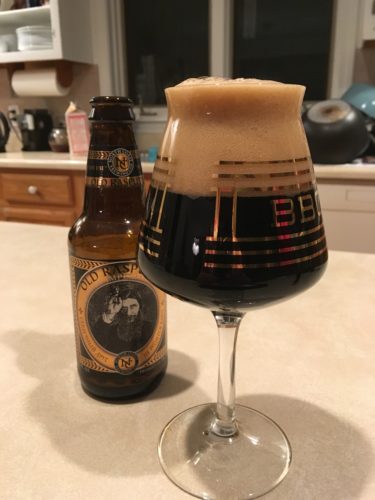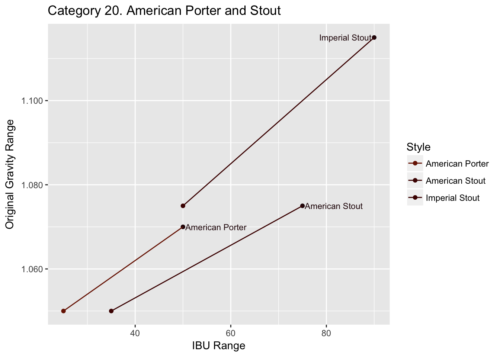BJCP Study Group: Category 20
¶ by Rob FrieselLike our study session for Categories 6 & 8, session #15 was double-booked with a club meeting. Only this club meeting was not a supplement to the study group, but rather the study group format was tweaked to accommodate the meeting. And so it goes.
Our modified format? Score an Old Rasputin at home and bring in the scoresheet for discussion.
Category 20: American Porter and Stout
The BJCP style guide’s description for this category goes something like this (emphasis added):
These beers all evolved from their English namesakes to be wholly transformed by American craft brewers. Generally, these styles are bigger, stronger, more roast-forward, and more hop-centric than their Anglo cousins. These styles are grouped together due to a similar shared history and flavor profile.
Which, if you ask me, sounds like a pretty typical modifier to describe an American style of what’s otherwise rooted in the British or European tradition.
| 20A. American Porter | 20B. American Stout | 20C. Imperial Stout |
|---|---|---|
| 25 – 50 IBU | 35 – 75 IBU | 50 – 90 IBU |
| 1.050 – 1.070 O.G. | 1.050 – 1.075 O.G. | 1.075 – 1.115 O.G. |
| 1.012 – 1.018 F.G. | 1.010 – 1.022 F.G. | 1.018 – 1.030 F.G. |
| 4.8 – 6.5% ABV | 5.0 – 7.0% ABV | 8.0 – 12.0% ABV |
Broadly speaking, these are bigger, hoppy, rich/complex dark beers. Drawing the differentiations between them can be an exercise in squinting through the blurry lines. The defining characteristic for an American Porter (20A) seems to be a “lightly burnt” quality, with a hop profile that is more resiny and earthy. Contrast this with 20B. American Stout, which leans more toward chocolate and coffee flavors, with citrusy hops and higher carbonation. 1 So between the two, if I were to boil it down: an American Porter puts more emphasis on malt and has a “lightly burnt” aspect, while the American Stout (though still having a big malt profile) is hoppier, fuller-bodied, and higher carbonation.
And then of course there’s the 20C. Imperial Stout which (as previously discussed) is something of a very broad, highly interpretable style. The emphasis here is on “richness” and “complexity” and “harmony”; something big, with a lot of alcohol. But also (quoting the style guide here) “not a hot mess.”
The Homework
Given that the study group session was double-booked with a club meeting, our group coordinator emailed everyone ahead of time: go get yourself a North Coast Old Rasputin, do a scoresheet, and bring it to the meeting to discuss.
For my part, I scored it a 43. 2 A delicious and complex beer, though I found that there was an “almost burnt toast” quality that (while not inappropriate) was somewhat distracting. I also felt like something was off with the level of carbonation, but I had a hard time articulating that — somehow it seemed simultaneously too high and too low.
Night of Study Session
During the club meeting, the BJCP study group pulled themselves aside for a few minutes to talk through our scoresheets. Almost all of us landed with scores in the low-40s; one member scored it a 37. Much of our conversation about this beer felt like a re-litigation of our RIS competition scoring exercise: When a style can be “low to high” on so many dimensions, that doesn’t mean “anything goes” — but how do you quantify the elements to articulate your observations about its balance? Where is the line between “complex, harmonious beer” and “a hot mess”? Can an element be stylistically appropriate but also out-of-balance with the rest of the beer? How do you express that?
Beyond that, we had a quick discussion of the other styles in the category. Of particular note: first, how the lines are sometimes blurred between the three, and especially between American Porter and American Stout; but also how there were so few “regular” American Stouts available on the shelf, how almost every stout was “dressed up” in some way — imperial versions, barrel-aged versions, oatmeal stouts, etc.
See Also: Founders Porter
Something that came up during the club meeting was how a Founders Porter, while on the BJCP list as an American Porter, was a good example of how the lines between 20A and 20B were blurry. I had a small sample that night, but then I did a scoresheet on it a few nights later. Indeed, this was an interesting exercise. The beer has very little of that “lightly burnt” aspect that the style guide mentions repeatedly as characterizing an American Porter; meanwhile, it has quite a bit of cocoa and toffee-like sweetness — both qualities more easily associated with an American Stout. And yet, the hop character of the Founders Porter seems low, and more of the resiny/earthy qualities expected from a Porter (as opposed to the more citrusy American Stout).
Takeaways
- Try not to double-book with a club meeting. Too many distractions.
- Get help navigating broad styles. The styles in Category 20 have a couple things going “against” them for more novice judges. First, the blurry line between American Porter and American Stout. Second, the wide-open field of the Imperial Stout. This is a great place to get guidance from an experienced judge.
- Filed under “I’m glad I studied!” My pre-conceived ideas about American Stouts were that they had lower carbonation than American Porters (generally speaking). And while that was derived from “field observations”, the style guide says otherwise.[↩]
- While I haven’t scanned in my scoresheet, here’s Gordon Strong’s take on Old Rasputin from a few years ago.[↩]


Leave a Reply